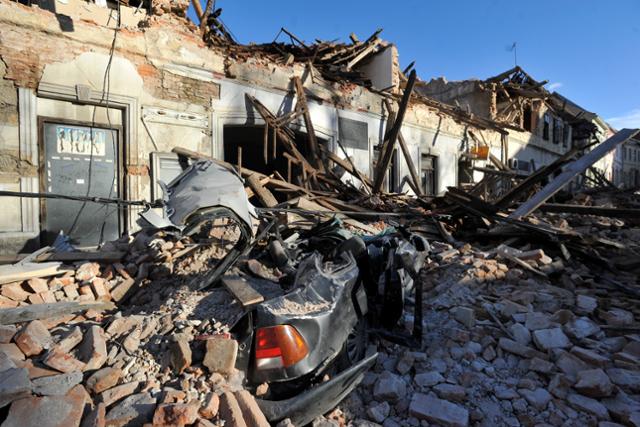
A building collapsed in a strong earthquake in central Croatia on the 29th, and a car was buried in the rubble. Petrinha = AP Yonhap News
On the 29th (local time), an earthquake of magnitude 6.4 occurred in a central city in Croatia, killing at least 7 people and injuring dozens. Half of the city was destroyed, and the power of the disaster was great as it was a strong earthquake in 140 years. There are many residents buried in the collapsed buildings, and the casualties are expected to increase significantly.
The Croatian Earthquake Agency tweeted on the day, “It is estimated that the intensity of the earthquake epicenter is 8-9. Earthquakes have been felt all over Croatia, and enormous material damage is expected.” The earthquake occurred in Petrinha, a city 50 km southeast of Zagreb, the capital, and its epicenter is 10 km deep. In central Croatia, there was an earthquake of magnitude 5.2 on the previous day.
Petriña Mayor Darinko Dumbovic told local broadcaster N1, “Half the city is completely destroyed and people are under the rubble of a building.” Panic.” The aftershock continued even during the mayor’s interview.
Prime Minister Andrei Flenkovic, who arrived in Petrína two hours after the earthquake, said, “We have not yet identified the casualties other than that a 12-year-old girl has died. Emphasized.
Injured people also appeared in the nearby city of Sisak. According to the Croatian state broadcaster HRT, a large number of injured people are being transported to local hospitals, resulting in a medical shortage. “Injured people mainly suffer from fractures and concussion symptoms, and some require emergency surgery,” said Tomislav Fabiyanik, chief of emergency medical care in Sisak.
At the earthquake site, military and mountain rescue teams are dispatched to search for survivors and casualties. Temporary shelters are also being prepared for residents. The Croatian government has pledged to support the cost of the damage recovery. European Union Commissioner Urzula Ponderrayen also posted a post on Twitter saying, “We are ready to send a support team to Croatia.”
The U.S. Geological Survey analyzed the earthquake as the largest earthquake in Croatia since the Zagreb earthquake in 1880. Vibration was also felt in neighboring countries Bosnia and Serbia, southern Austria, and far Italy. Slovenia temporarily closed the Krško nuclear power plant close to Croatia in case of emergency. The Earthquake Research Institute of Serbia said, “It is expected that several more earthquakes will occur in the future.”
In Croatia, a 5.5-scale earthquake hit Zagreb and neighboring cities in March of this year, causing great damage. At that time, the damage alone amounted to 13.3 billion euros (about 18 trillion won).
Kim Pyo-hyang reporter [email protected]
You can also view the news Naver Et edited by the Hankook Ilbo.

